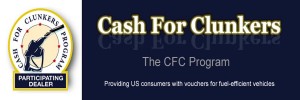
Dealers will be able to continue take up to 500,000 more trade-ins, now that the Senate has approved another $2 billion in Cash-for-Clunkers.
The Senate has approved another $2 billion to replenish the unexpectedly popular Cash-for-Clunkers auto incentive program, which has helped spur strong demand in an otherwise moribund American auto market.
The vote, late Thursday, mirrored action taken by the U.S. House of Representatives, a week ago, and with President Barack Obama’s signature, it means there will be enough money to keep the program, officially known as the Car Allowance Rebate System, going through Labor Day.
“Now more American consumers will have the chance to purchase newer, more fuel-efficient cars and the American economy will continue to get a much-needed boost,” the president said, following the Senate vote.
The initial, $1 billion Clunkers fund is believed to have helped about 250,000 American motorists to trade in their older vehicles for newer one. Under the program, qualified buyers receive vouchers of $3,400 or $4,500, depending on factors including the improvement in mileage made with the new vehicle. Sponsors predict another 500,000 buyers will receive pay-outs under the CARS extension.
The first round of cash ran out in little more than a week – though many dealers were already talking with customers weeks before the official start of the program. Hyundai actually created a program encouraging new buyers to come in at the beginning of July, advancing them the cash until the Clunkers program officially began.
Dealers around the country are reporting that their showrooms are filled with eager customers, though there’d been a sense of concern when the money began to run out, last week, and some key Senators expressed reservations about coughing up the initial $2 billion. In the meantime, a number of dealers began requiring buyers to sign forms that would have required them to pay back their incentives if the Senate voted against refinancing Clunkers.
“I couldn’t even find a place to sit at Royal Ford,” in Royal Oak, Michigan, said one buyer eager to trade in one of two clunkers in his garage. “I wanted to buy a domestic product,” said the consultant to the auto industry, asking that he not be identified by name, “but they had sold out of everything I wanted.” The consultant ultimately had to purchase an import.
Initial government data indicate foreign makers have been gaining a disproportionate share of the business generated by the Clunkers volume, reflecting their emphasis on smaller, more fuel-efficient products. But Detroit hasn’t been shut out entirely. The Ford Focus was the most popular model purchased using the vouchers – at least among the first 120,000 cars purchased under the CARS program. Meanwhile, the average passenger car bought using Clunkers cash got 28.3 mpg, while it was 21.9 mpg for SUVs and 16.3 mpg for pickups.
Reaction to the Senate vote was quick. “Consumers have already cast their vote and the CARS program is a clear winner,” said Marl LaNeve, head of sales, atGeneral Motors. “Our Customers and Dealers appreciate Congress’ help in keeping the program’s momentum going and providing the stimulus to put more clean, fuel efficient vehicles on the road. CARS is one program that has given consumers, the economy and a vital industry a much needed boost.”
But how long-term a boost the industry is getting is uncertain, cautioned Stephanie Brinley, analyst with AutoPacific, Inc. The answer, she noted, depends upon a variety of factors. If CARS is simply “pulling forward” purchases that would have been made later in the year, it could actually result in an even steeper decline in the American auto market later this year. Since January, sales are off by a third compared to an already-weak 2008.
“These buyers would have bought the cars anyway,” asserted Senator Richard Shelby, an Alabama Republican, who voted against the Clunkers extension.
In contrast, Senator Debbie Stabenow, insisted, “The reality is this is a program that has been working.”
On the other hand, the Michigan Democrat echoed the hopes, in industry circles, that buyers are trading in vehicles they would have otherwise run into the ground, or that they would have traded in on used, rather than new, cars, trucks and crossovers. In that case, said Brinley, Clunkers will likely add significant incremental volume to the mix.
How the numbers are interpreted is more than an academic issue. If the bump is seen as a brief one, the industry reaction is likely to be cautious. “We’re not going to complain about a program that helps people buy cars,” said Ford Chief Financial Officer, Lewis Booth, during an industry conference, earlier this week. But, he quickly cautioned, Ford also isn’t ready to rush to boost production unless it appears the market will retain its momentum once the second $2 billion infusion runs out.
One measure of success, analysts say, is whether there will be a noticeable bump in consumer confidence during the Clunkers program. While it may be impossible to directly attribute such an uptick to CARS, it would almost certainly help motivate more buyers to go back to the showrooms, even after the federal money runs out.
Lobbying group Public Citizen filed FOA demand for government Clunkers data. Click here for more.
